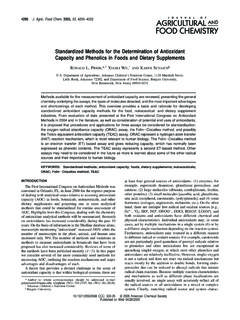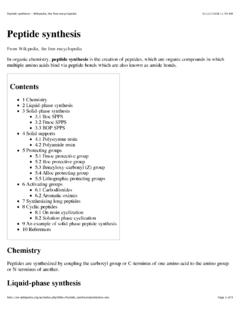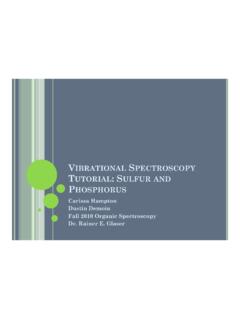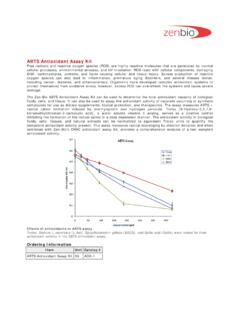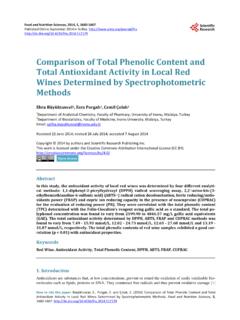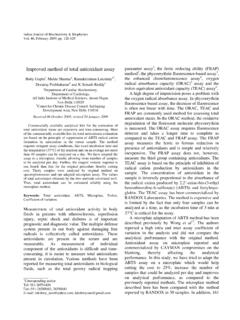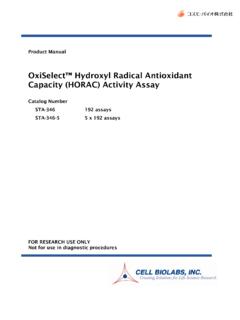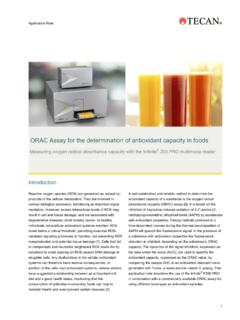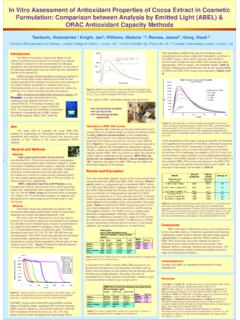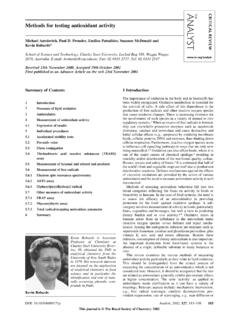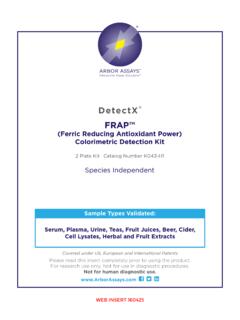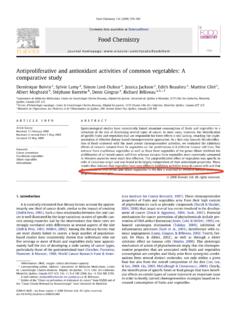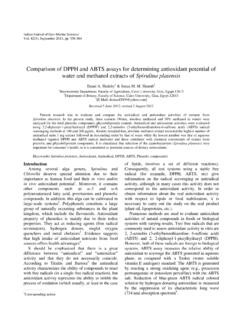Transcription of Comparative Study of Antioxidant Properties and Total ...
1 Comparative Study of Antioxidant Properties andTotal Phenolic Content of 30 Plant Extracts ofIndustrial Interest Using DPPH, ABTS, FRAP, SOD,and ORAC AssaysST EPHANIEDUDONN E, , XAVIERVITRAC,*, PHILIPPECOUTI`ERE, MARIONWOILLEZ, ANDJEAN-MICHELM ERILLON Biolandes, Route de Be lis, 40420 Le Sen, France, and Groupe d Etude des Substances Ve ge tales a`Activite Biologique, EA 3675, Institut des Sciences de la Vigne et du Vin, Universite Victor SegalenBordeaux 2, UFR Sciences Pharmaceutiques, 210 Chemin de Leysotte,33140 Villenave d Ornon, FranceAqueous extracts of 30 plants were investigated for their Antioxidant Properties using DPPH andABTS radical scavenging capacity assay , oxygen radical absorbance capacity (ORAC) assay ,superoxide dismutase (SOD) assay , and ferric reducing Antioxidant potential (FRAP) assay .
2 Totalphenolic content was also determined by the Folin-Ciocalteu method. Antioxidant Properties andtotal phenolic content differed significantly among selected plants. It was found that oak (Quercusrobur), pine (Pinus maritima), and cinnamon (Cinnamomum zeylanicum) aqueous extracts possessedthe highest Antioxidant capacities in most of the methods used, and thus could be potential richsources of natural antioxidants . These extracts presented the highest phenolic content (300-400mg GAE/g). Mate (Ilex paraguariensis) and clove (Eugenia caryophyllus clovis) aqueous extractsalso showed strong Antioxidant Properties and a high phenolic content (about 200 mg GAE/g).
3 Asignificant relationship between Antioxidant capacity and Total phenolic content was found, indicatingthat phenolic compounds are the major contributors to the Antioxidant Properties of these : Plant extract; Antioxidant activity; Total phenolic content; DPPH, ABTS; FRAP; ORAC; SODINTRODUCTIONB iological combustion involved in the respiration processproduces harmful intermediates called reactive oxygen species(ROS). Excess ROS in the body can lead to cumulative damagein proteins, lipids, and DNA, resulting in so-called oxidativestress.
4 Oxidative stress, defined as the imbalance betweenoxidants and antioxidants in favor of the oxidants (1), has beensuggested to be the cause of aging and various diseases inhumans (2-5). Hence, the balance between antioxidation andoxidation is believed to be a critical concept for maintaining ahealthy biological system (3, 6).It has been recognized that there is an inverse associationbetween the consumption of some fruits and vegetables andmortality from age-related diseases, which could be partlyattributed to the presence of Antioxidant compounds, especiallyphenolic compounds, which are the most abundant hydrophilicantioxidants in the diet and the most active antioxidantcompounds (7, 8).
5 Dietary antioxidants can stimulate cellulardefenses and help to prevent cellular components againstoxidative damage (9, 10). In addition, antioxidants have beenwidely used in the food industry to prolong shelf life. However,there is a widespread agreement that some synthetic antioxidantssuch as butylhydroxyanisole and butylhydroxytoluene (BHA andBHT respectively) need to be replaced with natural antioxidantsbecause of their potential health risks and toxicity (11).Therefore, the search for antioxidants from natural sourceshas received much attention, and efforts have been made toidentify new natural resources for active Antioxidant addition, these naturally occurring antioxidants can beformulated to give nutraceuticals, which can help to preventoxidative damage from occurring in the this investigation, water was used as an extraction solventto extract the hydrophilic antioxidants present in the , for use in food and nutraceuticals.
6 Aqueous plant extractsare nutritionally more relevant and would have obvious advan-tages in relation to certification and safety (12).Several assays have been frequently used to estimate anti-oxidant capacities in plant extracts including DPPH (2,2-diphenyl-1-picrylhydrazyl), ABTS (2,2 -azinobis (3-ethylben-zothiazoline 6-sulfonate)), FRAP (ferric reducing antioxidantpotential), and ORAC ( oxygen radical absorption capacity )assays (13-18). These techniques have shown different resultsamong plants tested and across laboratories (19).
7 * Corresponding author. Tel: (33)5 57 57 59 70. Fax: (33)5 57 5759 52. E-mail: Biolandes. UFR Sciences Agric. Food ,57,1768 CCC: $ 2009 American Chemical SocietyPublished on Web 02/06/2009 The aim of the present Study was to determine the totalphenolic content and to characterize the Antioxidant activitiesusing DPPH, ABTS, FRAP, ORAC, and SOD assays of 30selected plants currently used in the industry for fragrance,cosmetic, and food flavoring applications, in order to determinetheir potential in nutraceutical AND METHODSP lant following plants were obtained from Biolan-des s collection of plants.
8 Abelmoschus moschatus(Malvaceae, India),Actinidia chinensis(Actinidiaceae, France),Cananga odorata(An-nonaceae, Madagascar),Carica papaya(Caricaceae, Madagascar),Ceratonia siliqua(Fabaceae, Morocco),Cinnamomum zeylanicum(Lauraceae, Madagascar),Cistus ladaniferus(Cistaceae, Spain),Coffeaarabica(Rubiaceae, Brazil),Daucus carota(Apiaceae, France),Eu-calyptus globulus(Myrtaceae, Spain),Eugenia caryophyllus cloVis(Myrtaceae, Madagascar),Ilex paraguariensis(Aquifoliaceae, Brazil),Jasminum grandiflorum(Oleaceae, Morocco),Juniperus communis(Cupressaceae, Bulgaria),Laurus nobilis(Lauraceae, Morocco),La-Vandula augustifolia(Lamiaceae, France),LaVandula hybrida grosso(Lamiaceae, France),Liriodendron tulipiferum(Magnoliaceae, France),Matricaria recutita(Asteraceae, Morocco),Myrocarpus fastigiatus(Fabaceae, Paraguay),Pinus maritima(Pinaceae, France),Populus nigra(Salicaceae, China),Quercus robur(Fagaceae, France),Ribes nigrum(Grossulariaceae, France),Rosa damascena(Rosaceae, Bulgaria),SalViasclarea(Lamiaceae, France),Styrax benjoin(Styraceae, Laos)
9 ,Trigo-nella foenum graecum(Fabaceae, Morocco),Vanilla planifolia(Or-chidaceae, Madagascar) andZingiber officinalis(Zingiberaceae,India). ,2-Diphenyl-1-picrylhydrazyl (DPPH), 6-hydroxy-2,5,7,8-tetramethylchroman-2-c arboxylic acid (Trolox), 2,2 -azinobis(3-ethylbenzothiazoline-6-sulfo nic acid) diammonium salt (ABTS), po-tassium persulfate, fluorescein, 2,2 -azobis (2-methylpropionamidine)dihydrochloride (AAPH), phosphate buffer, 2,4,6-tri(2-pyridyl)-s-triazine (TPTZ), iron (III) chloride hexa-hydrate, and Folin-Ciocalteureagent were purchased from Sigma-Aldrich (France).
10 Sodium acetatetrihydrate was obtained from VWR Prolabo (France), iron (II) sulfatehepta-hydrate and gallic acid were from Acros Organics (France), andhydrochlorid acid and sodium carbonate were from the ICS Sciencegroup (France). SOD assay kit-WST was purchased from Interchim(France).Spectrophotometric and Spectrofluorometric and fluorescence measurements were respectively doneusing a UV mini-1240 Shimadzu spectrophotometer (Fischer Bioblock,France) and a Cary Eclipse spectrofluorometer (Varian, France). Theabsorbance measurements for the SOD assay were done using a Dynexplate reader (Serlabo Technologies, France).
